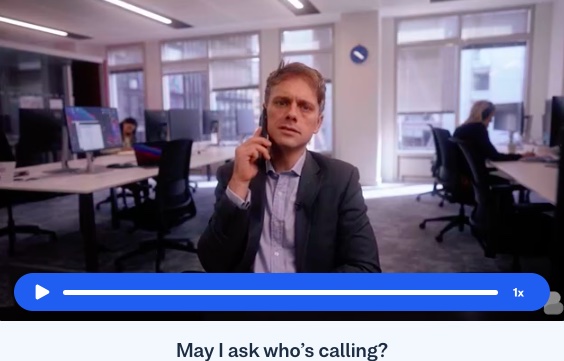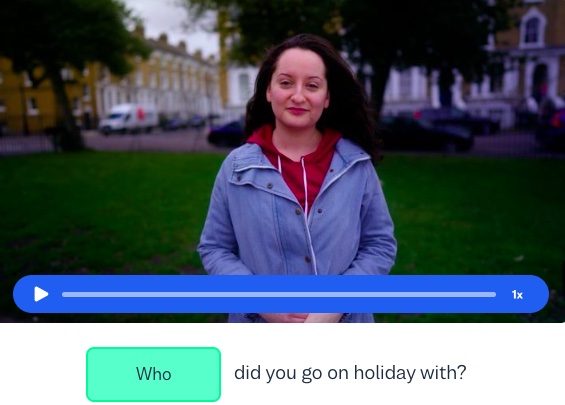Relative Clauses: The World of That, Who & Which
What is a relative clause? This simple guide will teach you exactly what they are, how to use them, and how they make sentences in English work.
I want to learn...
In English, you don’t have to wait too long before you hear the words that, who, which or whom pop up in sentences. These little words – known as relative clauses – are crucial when forming a sentence. They may not seem like a big deal, but they're really helpful when you're trying to explain something complicated or nuanced.
In this guide to relative clauses, we will look at the main uses of relative clauses. We will learn how we use them to talk about places, time, objects and people. And we will see why punctuation is so important when building sentences using relative clauses. And as always, we’ve got plenty of examples to help you learn.
Want to learn and master using relative clauses?
You will learn that the phrase "who’s calling" is a relative clause. It provides additional information about the subject of the verb "ask." With Busuu, you can learn the use of relative clauses and start using them like a native English speaker, via free online courses and learning resources!
What is a relative clause?
So what are relative clauses exactly and why do we use them?
A relative clause modifies a noun or pronoun using a relative pronoun (who, whom, whose, which, or that) or occasionally a relative adverb (when, where, or why).
Let’s look at this example below:
You are telling a friend about a park you used to visit when you were little. The next day, you read in the news that the park is undergoing renovations. The next time you see your friend, you want to share the update. There are three parts to the story:
- Yesterday I was telling you about a park.
- When I was little, I used to go to that park.
- Now the park is undergoing renovations.
But, instead of three simple sentences, you could use the relative clause to make one fluid sentence. You can do this by joining the three points together with a relative pronoun (that or which). The sentence would go like this:
- The park that I told you about, where I used to go when I was little, is undergoing renovations.
Now, this sentence has a little too much information and doesn’t feel very natural, so we can drop the first that.
- The park I told you about, where I used to go when I was little, is undergoing renovations.
This can happen when that is followed by a different subject.
In the following examples we can either use that or drop it without changing the meaning of the sentence.
- The car (that) I bought is in the garage.
- He’s the guy (that) I told you about.
- The letter (that) you wrote is very beautiful.
Remember this feature, as it will be useful later.
Now let’s focus on the types of sentences that we can create using relative clauses.
Relative clauses to talk about places
Let’s start by looking at how relative clauses help us specify information about a place.
- The street where I grew up is now completely different.
- I went to the park where we first met.
- The store on Main street, where we bought my new boots, is now closed.
As you can see, we can use the word where to talk about specific places.
In these sentences, where is like a bridge connecting two sentences: I grew up in this street + this street is completely different now.
When the relative pronoun is the object of the relative clause, we can substitute it with that. Let’s take the first two examples:
Main sentence: The street is completely different.
Relative clause: I grew up on this street.
Main sentence: I went to the park.
Relative clause: The park where we met.
In the first sentence, street is the object, therefore we can use that:
- The street that I grew up on is now completely different.
And in the second example, park is the object, so we can use that here too:
- I went to the park that we first met in.
When we use that, we still need to include the preposition, which is why we have:
“I grew up on that street,” and “the park that we first met in.”
Relative clauses to talk about time
Moving on to time-related relative clauses, we can see how these sentences help us pinpoint a specific moment or period of time.
- I met her when I was studying abroad.
- This was around the time when my daughter was born.
As we can see, when is used here as a pronoun for a relative clause, linking two sentences. It gives the listener a time frame for when the action occurred.
Relative clauses about objects
Most commonly, a relative clause can be about an object. To talk about objects, we use that or which. Look at these relative clause examples:
- She finally found the keys that she was looking for.
- This is the movie that everyone is talking about.
- Do you like the plants that I bought for the house?
- For the main course there is a vegetable soup, which I made from scratch.
- I’ve ordered pepperoni pizza, which should be here soon.
- The movie ended with a twist, revealing that the sister was guilty, which I already suspected.
Which and that are often interchangeable. Both words serve as relative pronouns and they introduce additional information about the noun. However, in English, no two words are 100% the same. There is always a little difference in tone or a little positive or negative nuance. Therefore, we talk about when to use that or which, it’s often a choice of style rather than a grammar rule.
If we take one of our previous examples:
- This is the movie that everyone is talking about.
- This is the movie which everyone is talking about.
The first sentence is probably more common but both are equally correct. This doesn’t mean that there are no differences at all in the way we use them.
Expert tip: When to use that or which
That is used in restrictive relative clauses, which are essential to the meaning of the sentence.
For example:
- The book that I borrowed from the library was excellent.
Which is used in non-restrictive relative clauses, providing additional information that can be omitted without changing the essential meaning of the sentence.
For example:
- I read the book, which I borrowed from the library, in one sitting.
Relative clauses and punctuation
It can be difficult to know when and how to use punctuation with relative clauses. Take a look at these examples.
- The book that my friend recommended is on the shelf.
- The book my friend recommended is on the shelf.
- The book, which my friend recommended, is on the shelf.
- The book (which my friend recommended) is on the shelf.
In the first two sentences, that isn’t part of a sentence within a sentence, but in the third and fourth sentence, which is part of a sentence within a sense. The commas or the brackets serve the same purpose, by signaling that to the reader. When speaking, they would both sound the same.
Relative clauses and relative pronouns to talk about people
Relative clauses relating to people will use another pronoun.
- The woman who lives next door is a doctor.
- I have a friend who speaks five languages fluently.
- Do you know the person who won the competition?
- She is the one who organized everything so smoothly!
The question word who also doubles as a relative pronoun and you are probably getting the pattern by now. In all of these examples who can be substituted by that:
- The woman that lives next door is a doctor.
Replacing who with that will not change the meaning of the sentence, but this change is not always possible. Remember those “sentences within a sentence” that we talked about above?
Take a look at some more examples:
- My grandmother, who is now 80, is not going to ride a motorcycle.
- The blonde woman, who I’d never spoken to before, came over to talk to me.
- Manuel, who worked in our Spanish branch until recently, is now a part of our UK team.
These are all examples of the type of context where we cannot exchange who with that. That’s because the “sentence within a sentence” can only be introduced by who.
Summing up relative clauses
Relative clauses play a crucial role in English grammar, allowing speakers to add detail, specificity and nuance to sentences. We have seen that relative clauses specify information about places, time, objects and people.
We also learned that relative pronouns (where, when, which, who) are often interchangeable with the pronoun that but this has an effect on the punctuation used in a sentence. All in all, relative clauses are fundamental when speaking English to help avoid repetition and make a sentence feel more natural.
Whether you are telling a story, presenting complex information or sharing opinions and thoughts, relative clauses are a fundamental tool to use when speaking English.
Want to keep learning?
Dive into the world of relative clauses and other tricky grammar topics that have always stumped you. With Busuu, you will have access to interactive learning materials and a community of native speakers to practice with.

